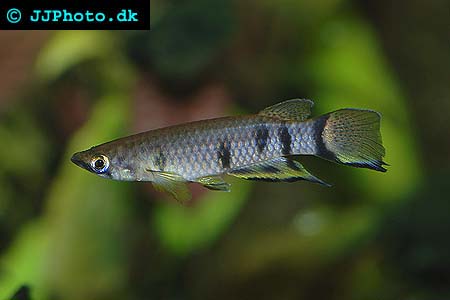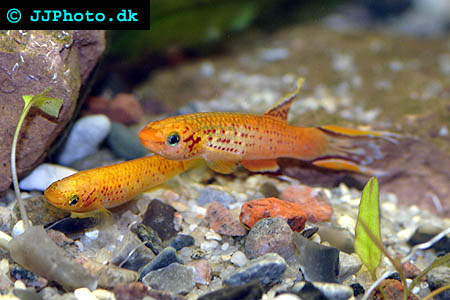Killiefish species are comparatively easy to keep in aquariums and also very beautiful, which have made them very popular among aquarists. Even a novice fish keeper can usually get the Killiefish into breeding condition in aquariums. Unlike many other popular aquarium species, the Killiefish is more often bought directly from breeders and not from fish stores or pet shops. Killiefish is sometimes spelled without the letter e, “Killifish”, and this is the original spelling and is derived from the Dutch word for creek. Killifish can therefore be translated as ‘creek fish’, and it is an aptly chosen name since many Killiefish species lives in creeks and streams. Killiefish can however also be found in larger rivers and lakes. Killiefish are common in Africa and Asia, and can also be found from Ontario in the U.S. and all the way down to Argentina on the southern tip of the South American continent. Wild Killiefish can also be found in Southern Europe, but not in Northern Europe or in Australia. Killiefish often live in tropical waters, but they can survive in colder waters as well, and even cold parts of Uruguay and Argentina are inhabited by Killiefish.
All the Killiefish species are small tooth carps belonging to the order Cyprinodontiformes. The biggest Killiefish species can reach a size of 6 inches (15 centimetres), but most species stay at a more modest length of 2 inches (5 centimetres) or less. Some Killiefish species form schools, but a majority of the species forms smaller social groups where a dominant male claims a territory and live with several female Killiefish. All male Killiefish will be violently chased away from the territory, except for very young ones that may be allowed to enter.
Killiefish inhabit very different environments and have adapted to different diets. Many Killiefish species will feed on insects, insect larvae, worms and crustaceans. Other Killiefish species, such as the Orestias, are filter feeders and live on plankton. There are also several Killiefish species that feed mainly on other fish. Killiefish are extremely capable predators and will affect the ecosystem in which they live considerably. In many areas where pollution has caused the Killiefish to diminish, the amount of mosquitoes has boomed. A booming mosquito population can cause in increase of malaria cases in areas where the illness is already present.
Since the Killiefish species inhabit such diverse environments all over the globe they have developed different reproductive strategies. Killiefish are often found in temporary flood plains and small ponds that will vanish once a year during the annual dry season. These Killiefish species will deposit their fertilized eggs safely in the mud, and the eggs will stay there until the rainy season begins once more. The parent fish will usually die when the dry season begins, and even when kept in aquariums these Killiefish species have a short life span. In the wild, it is rare for such a Killiefish to survive for more than 9 months. If you want to breed this type of annual Killiefish, you must simulate a dry season after the eggs have been deposited. The eggs are programmed to rest in the dirt during a dry season, and then hatch when the land is flooded with water once again.

Epiplatys dageti monroviae - a killie fish. Copyright www.jjphoto.dk
Killiefish species that do not live in vanishing floods or lakes usually spawn caves and rock crevices, or scatter their eggs on plants. Some Killiefish species build nests to protect their offspring. When it comes to reproductive methods, Killiefish from the genus Cynopoecilus are worth mentioning. These Killiefish use a form of pseudo-internal fertilization, which might show us the missing link between egg layers and the live bearing tooth carps.

A pair of golden Aphyosemion australe – Another species of killie fish. Copyright www.jjphoto.dk
Didn't find the info you were looking for? Register for free and ask your question in our Aquarium forum !
Our knowledgeable staff usually responds to any question within 24 hours
Related Articles
Aphyosemion - Information about Aphyosemion
Breeding Clown Killies. Epiplatys annulatus - Information about how to keep and breed clown killies.
Breeding Fundulopanchax gardneri Jos Plateau - A detailed guide on how to keep and breed this species.
Breeding Rivulus hartii - the Giant Rivulus - This killifish proved easy to breed and raise.
Breeding the Blue Gularis, Aphyosemion sjoestedti - A guide to keeping and breeding the blue gularis..
Cynolebias - Information about Cynolebias killi fish.
Epiplatys - Information about Epiplatys killi fish.
How to Make a Spawning Mop - Detailed instructions on how to make a killie spawning mop.
Killies - The Plant Spawners - The permanent and the mop methods of spawning. Incubation methods raising the fry.
Killie Mops - How to make and use these devices where killifish and other plant spawners can lay their adhesive eggs.
Nothobranchius - Information about Nothobranchius killi fish.
Shipping Killifish and Eggs. - A detailed article. Conditioning the fish. The water, bagging, containers. Carriers, receiving.
South American Killies - Cynolebias: True annual killifish that require slightly different treatment than Nothobranchius.
Spawning Cynolebias constanciae - This description of breeding this fish could apply equally well to other peat spawning annual killies.
Triggers - Triggers for killifish to breed and what you can do to convince those in your tanks that they should hatch.
Understanding Killifish Names - An explaination.



